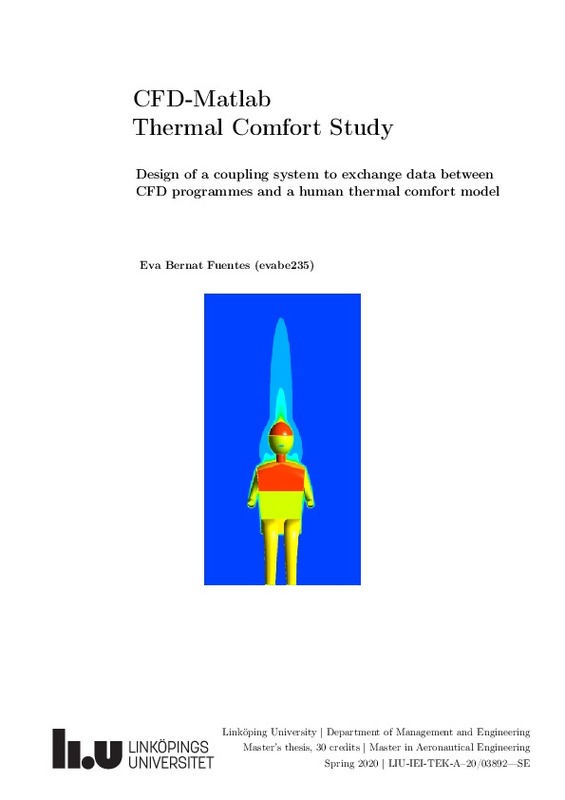JavaScript is disabled for your browser. Some features of this site may not work without it.
Buscar en RiuNet
Listar
Mi cuenta
Estadísticas
Ayuda RiuNet
Admin. UPV
CFD-Matlab Thermal Comfort Study Design of a coupling system to exchange data between CFD programmes and a human thermal comfort model
Mostrar el registro sencillo del ítem
Ficheros en el ítem
| dc.contributor.advisor | Tiseira Izaguirre, Andrés Omar
|
es_ES |
| dc.contributor.advisor | Gårdhagen, Roland
|
es_ES |
| dc.contributor.author | Bernat Fuentes, Eva
|
es_ES |
| dc.date.accessioned | 2020-10-28T18:03:25Z | |
| dc.date.available | 2020-10-28T18:03:25Z | |
| dc.date.created | 2020-09-14 | |
| dc.date.issued | 2020-10-28 | es_ES |
| dc.identifier.uri | http://hdl.handle.net/10251/153437 | |
| dc.description.abstract | [ES] El contenido del trabajo consiste en el estudio del comfort térmico en un ser humano dentro de la cabina de un avión. Para ello se acoplará el modelo existente 1D en Matlab del humano con un modelo 3D CFD en ANSYS de la cabina del avión. El trabajo muestra la importancia de la colocación estratégica de cada uno de los pasajeros dentro de un entorno cerrado como el fuselaje de un avión. las condiciones de cabina quedan expuestas al propio intercambio térmico con el medio de cada uno de los individuos. por lo tanto, es necesario, para evitar un derroche de energía del sistema de acondicionamiento de cabina la correcta distribución del aire en el pasaje y su renovación en cada instante de tiempo. | es_ES |
| dc.description.abstract | [EN] The general trend of increasing heat loads in modern passenger aircraft cabins e.g. caused by in-flight entertainment or novel energy sources, induces a rising demand for efficient yet comfortable ventilation systems. Therefore, the typical design and dimensioning criteria of conventional Aircraft Cabin Ventilation system concepts need to be verified to avoid problems concerning the thermal sensation and comfort of the passengers. Fanger’s Predicted Mean Vote-method is traditionally used for estimating thermal sensation and comfort. The PMV method does not take into account the human thermoregulatory system, therefore it progressively over-estimates the mean perceived warmth of warmer environments and the coolness of cooler environments. Aircraft Cabin CFD models existing in the industry tend to make use of constant temperature boundary condition to define a human being. The compromise on accuracy that this fact generates, brings the doubt about how making more realistic simulations. Human thermoregulatory models represent the human body from a thermokinetic point of view and they have been used for modelling the thermoregulation system. Their tissue heat transfer, thermal sensation and thermal comfort calculation has been successfully validated under various steady-state and transient indoor environment boundary conditions comparing the simulation results to measurements made with real human beings. From an existing Matlab model of a human being (approximated with 9 layers and 15 body parts) provided by Espuna [1], the main goal of this work is to connect it to the three-dimensional cabin model in ANSYS Fluent developed by Raina et. al. [2]. From it, local environmental conditions around a human body and the response of the human body to these conditions could be obtained, such as transient temperature changes at the skin. These last ones will be fed back to the CFD model to enable the effect that the body has on the local environment. This two-way data transfer has been thought to be important when modeling spaces with low air velocities according to Cropper [3], due to the impact that human body has on the local environment. The model regards an aircraft cabin. This simulation will have the goal of optimizing the thermal comfort for the passengers. The ventilation conditions tested will be Displacement Ventilation (DV) and a transient Thermal Comfort Model will be applied at a local and global level for each human. | es_ES |
| dc.format.extent | 72 | es_ES |
| dc.language | Inglés | es_ES |
| dc.publisher | Universitat Politècnica de València | es_ES |
| dc.rights | Reserva de todos los derechos | es_ES |
| dc.subject | Cabina | es_ES |
| dc.subject | ECS | es_ES |
| dc.subject | Modelo 1D | es_ES |
| dc.subject | CFD | es_ES |
| dc.subject | Temperatura | es_ES |
| dc.subject | Cabin | es_ES |
| dc.subject | Model 1D | es_ES |
| dc.subject | Temperature | es_ES |
| dc.subject.classification | INGENIERIA AEROESPACIAL | es_ES |
| dc.subject.other | Máster Universitario en Ingeniería Aeronáutica-Màster Universitari en Enginyeria Aeronàutica | es_ES |
| dc.title | CFD-Matlab Thermal Comfort Study Design of a coupling system to exchange data between CFD programmes and a human thermal comfort model | es_ES |
| dc.title.alternative | Estudio de confort térmico CFD-Matlab. Diseño de un sistema de acoplamiento para el intercambio de datos entre programas CFD y un modelo de confort térmico humano. | es_ES |
| dc.type | Tesis de máster | es_ES |
| dc.rights.accessRights | Abierto | es_ES |
| dc.contributor.affiliation | Universitat Politècnica de València. Departamento de Máquinas y Motores Térmicos - Departament de Màquines i Motors Tèrmics | es_ES |
| dc.contributor.affiliation | Universitat Politècnica de València. Escuela Técnica Superior de Ingeniería del Diseño - Escola Tècnica Superior d'Enginyeria del Disseny | es_ES |
| dc.description.bibliographicCitation | Bernat Fuentes, E. (2020). CFD-Matlab Thermal Comfort Study Design of a coupling system to exchange data between CFD programmes and a human thermal comfort model. Universitat Politècnica de València. http://hdl.handle.net/10251/153437 | es_ES |
| dc.description.accrualMethod | TFGM | es_ES |
| dc.relation.pasarela | TFGM\138001 | es_ES |
Este ítem aparece en la(s) siguiente(s) colección(ones)
-
ETSID - Trabajos académicos [8906]
Escuela Técnica Superior de Ingeniería del Diseño






